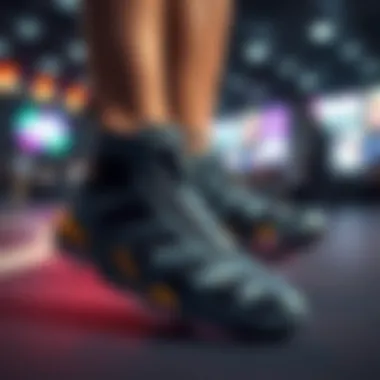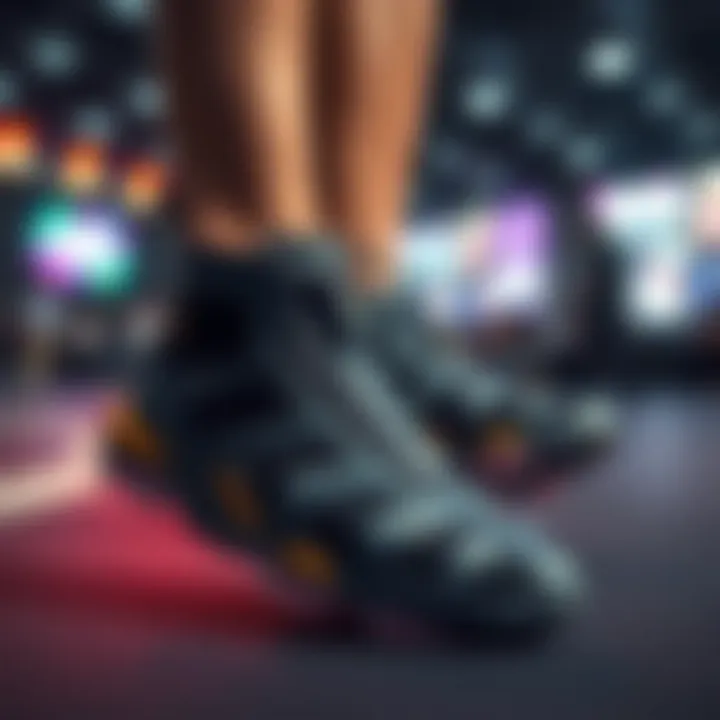Exploring the Unique Features of Webbed Shoes


Intro
Webbed shoes have become a notable contender in the expansive world of footwear, where style meets functionality in a particularly intriguing manner. Unlike more conventional options, these shoes boast an unusual design that features a webbed structure, often crafted from innovative materials that are both lightweight and durable. This article will explore the various aspects of webbed shoes, including their materials, practical applications, and how they fit into modern fashion trends.
In recent years, there has been a noticeable shift towards eco-conscious products, and webbed shoes stand at the crossroads of this movement. They typically utilize materials that minimize environmental impact, catering to a growing audience that values sustainability alongside aesthetic allure.
Moreover, the wearer’s experience is paramount when considering a purchase. Understanding how these shoes perform under various conditions—from beach outings to casual outings—provides potential buyers with valuable insights. This guide will serve as a resource for fashion designers, retailers, and marketers, shedding light on the multifaceted nature of webbed footwear.
Prelims to Webbed Shoes
The realm of fashion and footwear is continually evolving, with various styles emerging to meet consumer needs and preferences. Among these innovations, webbed shoes stand out as a notable addition, intertwining practicality and aesthetics in a unique way. Understanding the significance of this footwear not only offers insights into its growing popularity but also reveals the multifaceted benefits they bring to the table.
Historical Context
Webbed shoes have roots that can be traced back to diverse cultures and climates. Originally, functional footwear was designed for specific terrains, but over time, a blend of utility and style took center stage. In coastal areas where aquatic activities were part of daily life, such shoes provided optimal foot protection while remaining lightweight.
In the 1970s, the advent of synthetic materials gave birth to a new breed of shoes that could withstand harsh environments while offering breathability. Fast forward to the 1990s, and we see a resurgence of these designs, fueled by an increasing focus on outdoor sports and activities. This historical backdrop sets the stage for fully appreciating their modern iterations.
From its humble beginnings to the stylish and functional designs available today, the history of webbed shoes highlights a continuous evolution in footwear that prioritizes both performance and contemporary style. Tapping into this history lays a solid foundation for understanding the present-day applications and designs.
What Are Webbed Shoes?
Webbed shoes, in their essence, are a specific type of footwear characterized by a unique webbing pattern. Unlike traditional shoes, these utilize materials that are often lighter and more flexible, creating an experience that melds comfort with functionality. The design incorporates various types of webbing, often made out of durable synthetic options, to provide support and stabilization without weighing the wearer down.
Typically, webbed shoes comprise a mesh-like exterior that promotes airflow, making them an ideal choice for warm climates and water activities. This design allows for quick drying when exposed to moisture, ensuring that wearers can transition seamlessly between different environments.
Some of the significant characteristics of webbed shoes include:
- Lightweight Construction: Designed to minimize the weight, making them suitable for prolonged wear.
- Quick-drying fabric: Essential for users who engage in water activities, reducing discomfort associated with wet footwear.
- Ventilation: The open design allows for airflow, which helps in preventing odors and promoting overall foot health.
For lovers of both style and function, webbed shoes offer a gateway into practical elegance. Their defining features not only serve to enhance user experience but also contribute to the growing trend of merging fashion with functional design. As consumers become more discerning in their choices, understanding what webbed shoes encompass is crucial to making informed choices.
Design Features of Webbed Shoes
The design features of webbed shoes are critical in both functionality and fashion, providing insight into what sets these shoes apart from traditional footwear. When scrutinizing the elements that make up webbed shoes, one quickly realizes that the materials chosen, structural integrity, and overall design philosophy play crucial roles in determining their practical applications and user experiences. These attributes don't just serve aesthetic purposes; they significantly influence performance, comfort, and durability, making it essential to dissect their contributions carefully.
Material Choices
Types of Fabric
When it comes to the types of fabric, the focus tends to lean towards lightweight and water-resistant materials. Nylon and polyester are popular choices because they’re durable and resistant to the elements. These fabrics can withstand moisture and wear, making them ideal in settings like beaches or watersports, where durability is a must. Moreover, the ability to dry quickly after exposure to water is a unique feature of these fabrics, allowing wearers to transition seamlessly from water activities to dry land without discomfort. However, it must be noted, while durable, these materials can sometimes lack breathability, especially in warmer weather, leading to sweaty feet if worn for too long.
Breathability Considerations
Breathability is another critical aspect that can’t be overlooked. Materials that allow air circulation—like mesh or specialized fabric blends—are favorable when considering comfort. This quality is essential; it helps to keep your feet cool during hot days and reduces moisture accumulation, potentially preventing blisters. A well-ventilated shoe means greater comfort over prolonged wear, allowing users to engage in various activities without discomfort that could stem from overheating. On the downside, however, highly breathable shoes may sacrifice some waterproof capabilities, which could pose challenges in certain environments.
Sustainability of Materials
Sustainability is a growing concern in today's conscious consumer market, and the materials used in webbed shoes often reflect this trend. Recycled fabrics and eco-friendly materials are becoming more prevalent, allowing brands to appeal to eco-conscious shoppers. This choice not only reduces waste but also provides consumers with a sense of participating in a larger movement toward sustainability. Nonetheless, it’s worth mentioning that sourcing sustainable materials can sometimes lead to higher production costs, affecting the retail price of such shoes.
Structural Elements
Webbing and Support
The role of webbing and overall support in webbed shoes cannot be understated. Webbing systems are integral, as they provide stability and help in securing the foot in a comfortable position, especially in adventure scenarios. These webbing systems distribute pressure evenly, which reduces the risk of abrasions during intense activities. However, over time, wearers may find that the webbing begins to stretch, potentially leading to a less secure fit, which can be a drawback.
Footbed Design
Footbed design is where comfort ultimately meets structural purpose. Many webbed shoes come equipped with contoured footbeds that cradle the foot, enhancing overall comfort during wear. This ergonomic feature not only alleviates pressure points but also provides arch support, which is particularly beneficial for users with active lifestyles. However, if the footbed is too cushioned, it may lead to reduced ground feedback, which might hinder balance when engaged in activities requiring precise foot control.
Grip and Traction
Last but not least, grip and traction are non-negotiable elements in the design of webbed shoes. The soles are often crafted from rubber compounds designed to maximize traction on wet surfaces. This feature is particularly important for water-related sports or hiking, where slip resistance can mean the difference between stability and a fall. Conversely, it is essential to recognize that while the focus on grip enhances safety, sometimes the aggressive tread patterns can lead to a less smooth transition on hard surfaces.


"The right blend of materials and design in webbed shoes can enhance the overall user experience significantly, proving that not all footwear is created equal."
In summary, the design features of webbed shoes reflect a thoughtful balance of materials and structure aimed at providing comfort, style, and performance. Each element—from fabric choice to structural integrity—works in tandem to create a footwear solution that caters to diverse consumer needs.
Functional Applications of Webbed Shoes
Webbed shoes are more than just a seasonal fad; they bridge the gap between functionality and style, appealing to a wide range of consumers. The importance of exploring the functional applications of these shoes lies in understanding how they perform in diverse settings. This investigation digs into their adaptability, which showcases how webbed shoes can enhance specific activities like sports and casual wear while prioritizing comfort and utility. In light of growing demand for multi-functional footwear, knowing how webbed shoes fit into everyday life and various physical pursuits becomes essential for both consumers and retailers.
Sports and Recreation
Water Sports Usage
When we're talking about water sports, webbed shoes can really be a game changer. Designed specifically for wet conditions, they're often made with materials that dry quickly and provide a secure grip on slippery surfaces. This key characteristic sets them apart, making them a preferred choice for kayaking, paddleboarding, or even beach volleyball.
Unique Feature: The drainage holes found in many webbed shoes allow water to flow out easily, preventing the shoe from becoming waterlogged. This advantage means less added weight and discomfort while you’re having fun in the sun.
However, there's a downside – not all webbed shoes offer adequate support for long-term wear, especially if you're spending hours standing or engaging in intense activity. Thus, while appealing for water sports, it’s crucial to check the shoes' overall stability and support features.
Trail Running and Hiking
Webbed shoes aren't just confined to water; they’ve found their footing on trails and rugged paths. This is largely due to their lightweight nature, providing a level of breathability that enhances long-distance runs or hikes. A significant draw is how these shoes limit foot fatigue while ensuring versatility on various terrains.
Unique Feature: Many trail-ready webbed shoes come with enhanced grip soles that allow better traction on uneven surfaces. This can be a tremendous asset when tackling steep or rocky paths.
But here’s the catch: while they're great for short runs or day hikes, the lack of cushioning in some models might leave some users yearning for more comfort after several hours on the trail. Therefore, careful consideration of the distance and terrain is vital.
Everyday Versatility
The beauty of webbed shoes lies in their everyday versatility, making them suitable for casual wear as well. People appreciate how they can seamlessly transition from a day at the park to a quick outing, maintaining that casual yet put-together look.
Unique Feature: Their stylish designs, available in various colors and styles, enable users to mix and match with diverse outfits without losing comfort. It gives a fresh vibe suitable for a relaxed weekend or a backyard barbecue.
However, not all webbed shoes maintain the same level of style, and some might appear too sporty for a nice dinner out or formal gathering. This is a crucial consideration for consumers who value both practicality and aesthetics in their footwear choices.
Everyday Wear
Casual Outfits
Casual outfits take on a new dimension with webbed shoes, which have an effortless way of complementing laid-back attire. The trendy appearance appeals to fashion-conscious individuals who want comfort without sacrificing style.
Unique Feature: The fusion of sporty elements with everyday wear allows webbed shoes to fit seamlessly into a variety of settings. Be it a trip to the farmer's market or a stroll in the park, they add an edge to simple outfits while being super easy on the feet.
A downside is that while they're great for casual wear, they may not have that polished look for more formal occasions, which can limit their use for people who enjoy dressing up.
Travel Convenience
For travelers, webbed shoes are a revelation. They are often lightweight and packable, making them an address of choice when space is an issue.
Unique Feature: Easy to slip on and off, they’re perfect for airport security checks or beach days without missing a beat. This convenience makes them a practical option for day trips or extended vacations.
On the flip side, not every pair provides sufficient arch support for all-day wear. Travelers must ensure they've selected wisely, balancing comfort with style as they pack.
Comfort in Urban Environments
Navigating city streets can be a challenge, and webbed shoes cater to this demand with their comfort-first design. Made with materials that enhance breathability while maintaining support, they can be a dependable choice for urban dwellers.
Unique Feature: The cushioned insoles often found in many models provide much-needed relief for those long days on foot, offering a functional solution to city life.
Nevertheless, wearers should pay attention to aesthetic fit—some styles may come off too casual or overly sporty when paired with office attire. Finding that sweet spot is key for those who straddle the line between comfort and professionalism in urban settings.
Consumer Insights and Trends
Understanding consumer insights and trends is crucial in the landscape of webbed shoes, as it reveals the motivations and preferences driving the market. This section delves into the target demographics and examines the current market trends that shape consumer choices. By recognizing these elements, stakeholders such as designers, retailers, and marketers can better tailor their products and strategies to meet the evolving demands of consumers.


Target Demographics
Active Lifestyle Consumers
Active lifestyle consumers are those who integrate physical activities into their daily routines, placing a high value on footwear that supports their dynamic habits. Webbed shoes resonate strongly with this group due to their lightweight construction and breathability, making them ideal for activities ranging from jogging to hiking. The versatility of these shoes reflects the primary characteristic of active consumers—they seek functionality without compromising style.
Being active often requires footwear that adapts well to various conditions. The breathable materials and grip offered by webbed shoes provide the needed comfort and security. That said, this demographic may face challenges with durability when participating in high-impact activities, which might limit their use in more rugged environments.
Eco-conscious Shoppers
In today's marketplace, eco-conscious shoppers stand on the frontlines of sustainability, actively seeking products that align with their values. This group appreciates the use of recycled materials and sustainable production methods in webbed shoe designs. The key characteristic of these shoppers is their desire for transparency regarding the environmental impact of their purchases; thus, brands that communicate their sustainable practices are more likely to capture this audience.
While the emphasis on sustainability is commendable, it sometimes leads to misconceptions about performance and longevity. Some eco-friendly materials may not perform as well as traditional options under certain conditions, and consumers must weigh these factors carefully before committing to a purchase.
Fashion-forward Individuals
Fashion-forward individuals are trendsetters who embrace innovation and unique design aesthetics. They recognize that webbed shoes can serve as a statement piece in any outfit, blending functionality with style. Their characteristic boldness leads them to select colors, patterns, and silhouettes that stand out.
The appeal for this demographic lies in the intersection of functionality and fashion; webbed shoes enhance their personal style while offering comfort. However, the challenge often comes from the fluctuating nature of fashion trends, making it essential for brands to regularly update their designs to maintain appeal among this audience.
Market Trends
Growing Popularity
The growing popularity of webbed shoes can be attributed to a number of factors, including an increase in outdoor activities and the shift toward casual, athleisure styles. This trend has encouraged consumers to seek out footwear that is not only functional for sports but also stylish enough for everyday wear. The boost in visibility of webbed shoes is beneficial for the industry at large, driving more brands to enter the market and create competition.
This rise may lead to a broader acceptance of webbed shoes in various settings, but it also raises the stakes for brands. They must ensure that their products stand out through unique selling points, as merely joining the bandwagon may not suffice.
Diversity in Designs
The diversity in designs available in the webbed shoe market is remarkable, reflecting varying consumer preferences and needs. From sporty variants to more chic interpretations, the multitude of styles allows consumers to choose shoes that not only serve their functional needs but also cater to their aesthetic preferences. Emphasizing diversity is a strength for brands, as it encourages them to innovate and attract a wider customer base.
However, having a wide array of options can confuse consumers. With too many choices, they might feel overwhelmed, making it crucial for brands to provide clear communication on the differentiators of each shoe model.
Influence of Social Media
Social media plays a pivotal role in shaping consumer behavior today. With influencers showcasing webbed shoes in their posts, these shoes have become more visible than ever, prompting users to consider them as trendy options. This visibility not only informs potential buyers about styles but also fosters community around the product.
Yet, the fast-paced nature of social media can lead to trends appearing and disappearing rapidly, creating a sense of urgency among consumers. Brands must stay vigilant in understanding these shifts to ensure their designs remain relevant.
Challenges and Critiques
In any burgeoning market, scrutiny often falls on the emerging products, and webbed shoes are no exception. This segment of the article dives into the challenges and critiques these innovative footwear face. Understanding these elements is essential not just for consumers, who seek reliable and fashionable options, but also for designers and retailers, tasked with meeting market demands and addressing concerns. An in-depth look at challenges sheds light on how the industry can enhance user experiences while balancing style and practicality.
Durability Concerns
Durability is a paramount consideration when it comes to footwear, and webbed shoes often experience skepticism in this regard. Given their design, which features webbed materials, there's a perception that these shoes might wear out quicker than traditional styles. Users often express worries about whether their investment in webbed shoes will stand the test of time.
However, it's important to note that advancements in fabric technology have allowed manufacturers to create highly durable webbed shoes. Brands now use strong synthetic materials that resist wear and tear, even under harsh conditions. Technologies such as reinforcement stitching and high-strength nylon are employed to produce tough products that can withstand a variety of environments.
In summary, while durability concerns exist, they are less about the material itself and more about the brand commitment to quality craftsmanship. Regular maintenance, such as proper cleaning techniques and being mindful of storage conditions, can further prolong the lifespan of webbed shoes. It's crucial for consumers to scrutinize reviews and brand reputations before purchasing to ensure they choose a model known for longevity.
Fit and Comfort Issues
Fit and comfort go hand in hand when selecting any footwear. While webbed shoes often boast a lightweight and flexible build, some users report issues with fitment and support. The unique design can feel less structured compared to conventional shoes, which may lead to discomfort during extended wear.
Many individuals find themselves frustrated when they try webbed shoes, particularly if they aren’t accustomed to the lack of traditional arch support. Consequently, it’s essential to reference sizing charts and consider customer feedback on fitting before making a purchase. Some brands have begun to innovate with built-in footbeds that enhance comfort, addressing these fit concerns directly.
"Choosing the right size can make or break the wearability of webbed shoes; ensure you know your foot's unique shape and measurements before buying."
It’s also worth noting that comfort can vary significantly across different activities. For casual outings, many users find webbed shoes to be perfectly adequate, while more demanding activities might require additional support. Buyers should think critically about their primary use case, as this will guide their selection process effectively.
Supporting further insights into durability, materials, and comfort-optimized designs, resources such as Wikipedia and Britannica offer foundational knowledge on footwear development. For user feedback and product discussions, platforms like Reddit can provide valuable information.


By understanding these challenges and critiques, both consumers and industry professionals can better appreciate the complexities involved in the ongoing evolution of webbed shoes.
Care and Maintenance of Webbed Shoes
Taking care of webbed shoes is one of those things folks often overlook until it’s too late. Just like a trusty pair of jeans, the longevity of webbed shoes relies greatly on how well they are treated. Given their various functionalities, from water sports to casual outings, a proper regime of care ensures they not only perform well but also look good while doing it. By maintaining these shoes, you not only extend their lifespan but also ensure comfort and hygiene.
Cleaning Tips
Cleaning your webbed shoes doesn't have to feel like a chore; it's simply part of keeping them in tip-top shape. Here are some pointers to ease the process:
- Rinse Right After Use: After any activity, particularly water-related ones, rinse the shoes with fresh water. This step washes away dirt, sand, or salt, which can wear down materials over time.
- Gentle Soap: When deeper cleaning is necessary, use a mild detergent. Harsh chemicals can break down the shoe's fibers, so stick to simple soaps that do the trick without wreaking havoc.
- Scrub Softly: Grab a soft-bristled brush to tackle any tougher spots, but don’t go hammering away; you want to avoid damaging the material. A delicate touch goes a long way.
- Air-Dry: Never toss them in the dryer. Instead, air-dry them in a shaded area. Direct sunlight can fade colors and compromise structural integrity.
Doing these steps regularly should keep your webbed shoes looking sharp and performing well.
Storage Recommendations
When it comes to safely stowing away your webbed shoes, there are also a few handy practices to consider.
- Cool and Dry Place: Avoid humidity and excessive heat, as these can cause mildew or unwanted warping. A dry closet or shelf is a good spot.
- Positioning: Try to keep them upright, or if that’s tricky, filling them with newspaper can help maintain shape and absorb excess moisture.
- Avoiding Compression: Don’t stack other shoes on top of them. Twisting or compressing can deform the shoe's structure and fit.
"Proper care and storage can mean the difference between a soggy mess and a great adventure with your webbed shoes."
Adhering to these care and storage suggestions will not only make sure you’re stepping out in style but will also help in making informed decisions when it’s time for a new pair. Trust me, your feet—and your bank account—will thank you.
The Future of Webbed Shoes
The future of webbed shoes is a dynamic topic rooted in innovation and consumer evolution. As society shifts towards more sustainable and functional products, webbed shoes are poised to take center stage. Their practical applications and unique design elements offer a variety of benefits, making them an enticing choice for both producers and consumers. The footwear industry has witnessed a gradual transformation, embracing technologies that both enhance performance and cater to environmental consciousness.
Innovative Technologies
Consider how advancements in material science could redefine webbed shoes. The integration of smart textiles is one such innovation on the horizon. Think about fabrics that not only offer durability but also have moisture-wicking properties. These are essential features for those engaging in water sports or outdoor activities. Manufacturers are increasingly exploring the use of 3D printing not just for customizing shoes but also for optimizing structural integrity at a lower production cost.
Additionally, the incorporation of wearable tech is an exciting prospect. Imagine shoes equipped with sensors that track your movements or analyze your foot biomechanics. This could be especially beneficial for athletes looking to enhance performance. Equipped with GPS features, webbed shoes could even guide you on various terrains, ensuring better navigation through unknown paths.
"With the right innovations, webbed shoes could not only redefine comfort but also enhance personal performance fundamentally."
Sustainable Design Practices
In today’s environmentally-conscious world, sustainable design practices are not merely a trend; they are a necessity. What distinguishes future webbed shoes is the commitment to sustainability. Companies are progressively opting for recycled and organic materials. For instance, using recycled plastics to create waterproof elements can significantly reduce landfill waste.
The lifecycle analysis is another critical aspect. Brands focusing on the entire life of the shoe— from production to disposal—are more likely to resonate with eco-minded consumers. Not only does this approach fine-tune the manufacturing process but it also encourages circularity in fashion. Consumers are increasingly wary of fast fashion and are in search of products that promise longevity.
Consider collaboration with organizations focused on environmental protection. Partnerships could lead to initiatives that plant a tree for every pair sold or contribute to ocean clean-up projects. Such practices not only enhance brand loyalty but also create a community around shared values.
Closure and Final Thoughts
As we reach the end of our exploration into webbed shoes, it’s essential to reflect on the central themes discussed throughout this article. Webbed shoes represent a unique convergence of fashion and practicality, which is increasingly valued in today's fast-paced environments. Their design focuses on various elements like breathability, comfort, and style – making them a worthwhile investment for diverse activities, whether for sports or casual outings.
Understanding the attributes of webbed shoes not only helps consumers make smarter choices, but also informs fashion designers and retailers about the evolving preferences of their customers. With the public's awareness of sustainability rising, incorporating eco-friendly materials into design practices is no longer just a trend; it’s becoming a consumer expectation.
Additionally, consumer insights and market trends reveal that the popularity of webbed shoes is growing, especially among those seeking versatility and comfort. The challenges related to durability and fit need to be acknowledged, as they can influence brand loyalty and customer satisfaction. Therefore, engaging with these challenges head-on can lead to better product iterations and enhanced user experience.
In summary, the intricate details surrounding webbed shoes provide a rich context for understanding their significance in the footwear market. The evolution of design, material choices, and practical applications are all vital components that contribute to a more informed consumer base and innovative practices in the industry.
Summary of Key Points
The analysis in this article underscores several key components:
- Historical Context: Webbed shoes, rooted in diverse cultural usages, showcase an evolution in design that reflects changing lifestyle demands.
- Design and Functional Features: Materials from various sources provide breathability and support, targeting a wide range of consumers, from athletes to casual wearers.
- Market Trends: The growing popularity of webbed shoes is underscored by the influence of social media and collaboration with sustainability advocates.
- Consumer Perspectives: Understanding user experiences around comfort and durability can crucially impact market dynamics.
Sharing these insights allows designers and marketers to better align their strategies with consumer needs, ultimately leading to more successful and responsible product offerings.
Encouraging Informed Choices
In a market flooded with choices, it is inherently vital for consumers to remain well-informed. This article serves as a reminder of the importance of:
- Research: Always delve into the product details before making a purchase. Understanding materials and purpose will lead to happier buying decisions.
- Reviews: Seek feedback from other users. Peer opinions often provide valuable insights that marketing materials fail to address.
- Sustainability: Identify brands that prioritize eco-friendly materials and practices, which ultimately can benefit the environment we live in.
- Versatility: Consider how webbed shoes fit into your lifestyle. Are they suitable for your activities — be it hiking, water sports, or just a casual stroll?
Informed consumers drive industry trends and push brands towards better practices. By keeping yourself educated, you not only enhance your personal choices but also contribute to a broader shift toward conscientious consumerism in the footwear arena.















